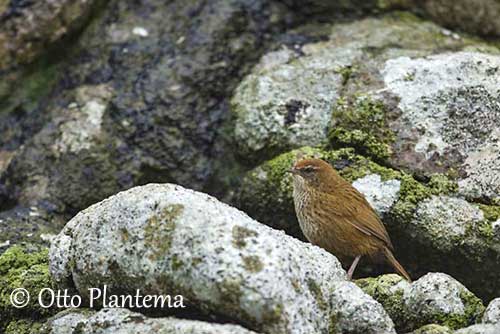
Fr: Mégalure matata
Ang: New Zealand Fernbird
Maori: Matata
All: Farnsteiger
Esp: Yerbera Maorí
Ita: Forapaglie codone punteggiato
Nd: Varengrasvogel
Sd: Nya Zeelandgräsfågel
Photographers:
Otto Plantema
Trips around the world
Simon Tan
PBase Bird galleries
Text by Nicole Bouglouan
Sources:
HANDBOOK OF THE BIRDS OF THE WORLD Vol 11 by Josep del Hoyo, Andrew Elliott and David Christie - Lynx Edicions - ISBN: 849655306X
KNOW YOUR NEW ZEALAND BIRDS by Lynnette Moon - New Holland Publishers – ISBN: 1869660897
BirdLife International (BirdLife International)
New Zealand bird status between 2008 and 2012
New Zealand birds and birding (Narena Olliver)
Wikipedia, the free encyclopaedia
Tiritiri Matangi Open Sanctuary
Home page
Page Passeriformes Order
New Zealand Fernbird
Megalurus punctatus
Passeriformes Order – Locustellidae Family
INTRODUCTION:
The New Zealand Fernbird is a very secretive species living in thick vegetation and moving mainly on foot or in short flights. Short wings and long tail are two typical morphological features.
The English name of this bird “fernbird” is not related to the habitat, but to the tail’s tattered appearance similar to fern fronds.
The local Maori name is “Matata”.
DESCRIPTION OF THE BIRD:
Biometrics:
Length: 18 cm
Weight: 35 g
The adult has brown, boldly streaked plumage. The nominate race has brown streaked blackish head, upperparts and wings. The long, graduated tail is dull brown, with the rectrices shading blackish towards the shaft. The tail shows often a tattered appearance.
On the underparts, chin, throat, breast and belly are whitish, with fine blackish spotting and streaking on breast. Flanks, breast side and undertail-coverts are brown with blackish streaking, more conspicuous on flanks.
On the head, forehead and crown are more chestnut than brown. We can see a more or less diffuse whitish supercilium. The ear-coverts are grey-brown with fine darker streaking merging into the brown of the upperparts at neck side.
The bill is blackish with greyer lower mandible. The eyes are dark brown. Legs and feet are pinkish-brown.
Both sexes are similar and the juvenile resembles adults.

SUBSPECIES AND RANGE:
Five extant subspecies are recognized. They differ in extent of reddish-brown and intensity of streaking, as well as size.
M.p. vealeae occurs on North I, New Zealand. This race is less rufous, mostly olive-brown overall.
M.p. punctatus (here described and displayed), is found on South I, New Zealand.
M.p. stewartianus occurs on Stewart I.
M.p. wilsoni is found on Codfish I, off NW Stewart I.
M.p. caudatus (displayed) occurs on Snares Is, S of Stewart I. This race has brighter reddish-brown plumage. Ear-coverts are distinctly darker. Legs and feet are slightly darker too.

HABITAT:
The New Zealand Fernbird frequents dense wetland vegetation, and a variety of shrubby and grassy habitats. But it can also be found in drier portions of swamps, shrubby saltmarshes, wetlands with emergent vegetation and tussock-grass areas. This species occurs from sea-level up to 1000 metres of elevation.
The race “caudatus” forages on the forest floor of Senecio and Olearia forests on Snares Is (Asteraceae).


CALLS AND SONGS: SOUNDS BY XENO-CANTO
The New Zealand Fernbird’s song includes quick whistles and clicks, often indicating the bird’s presence.
The contact between mates is a duet, a low “uu” by the male, and a sharp “tick” reply by the female.
The calls are mostly metallic. When disturbed or alarmed, the male gives a typical “too-lit”, and a rapidly repeated “di,di,di,di”.
BEHAVIOUR IN THE WILD:
The New Zealand Fernbird feeds on invertebrates such as insects, caterpillars, grubs, beetles, flies and moths, and tiny spiders emerging from cocoons. It may sometimes feed on seeds and fruit.
This species has strong leg bones, allowing it to forage mainly on the ground, through the rushes. It clings to the stems and perches on grasses and flax. It also climbs up to foliage in little runs, like a mouse. It is often reluctant to take off.

On Snares Is, the race “caudatus” feeds mostly in the open, taking maggots and flies around dead Spheniscidae. It perches on the back of marine mammals while feeding on flies.
The New Zealand Fernbird is monogamous. The mates remain together all year round, and have long-term pair-bonds. They usually remain close to their breeding territory. They become noisier in spring, and territorial disputes may occur.
The species is mainly resident but the juveniles disperse and search for own breeding territories, about 20 km from the parental territory, usually in patches of grassland or marsh.
The New Zealand Fernbird performs weak flight when it is forced to leave the cover. The short wings and the long tail make difficult a good flight. It flutters low across the vegetation, with the tail drooped down.
REPRODUCTION OF THIS SPECIES:
The breeding season occurs between August and January in most of range, but later on Snares Is, mostly between mid-October and mid-February.
Both mates build the nest. This is a loose, deep, cup-shaped structure made with woven grasses, sedges and rushes. The cup is lined with feathers. It is well hidden in the dense vegetation, between 15 and 75 centimetres above the ground or the water. Some nests are built in saltmarsh sedges, but they are sometimes flooded by the spring tides.

The female lays 2 eggs on islands, and 3-4 eggs on mainland. Eggs are pale pink with brown spots and dots. Both adults incubate during 13 days, mostly 16 days on Snares Is.
The chicks are fed on tiny insects by both parents. They fledge about 15-17 days after hatching, mostly 20-21 days on Snares Is. They can breed at 9 months old.
The pair rears 2-3 broods on mainland, but a single brood is laid on Snares Is. The juveniles still depend on parents for food for a few weeks after leaving the nest.
PROTECTION / THREATS / STATUS:
The New Zealand Fernbird’s populations are affected by drainage of wetlands and predation by introduced species, and especially rats.
However, the species is locally common in suitable habitat, and populations are suspected to be increasing. The Snares’ population is estimated at 1,500 pairs, but the global population is unknown.
The New Zealand Fernbird is currently evaluated as Least Concern.
